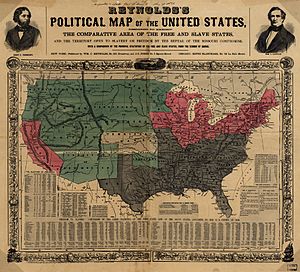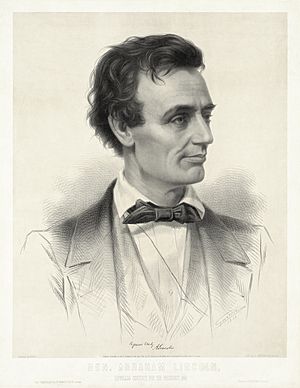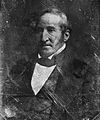Kansas–Nebraska Act facts for kids
The Kansas–Nebraska Act was a law passed in 1854 in the United States. It created two new areas, called Kansas and Nebraska. Senator Stephen A. Douglas of Illinois and President Franklin Pierce helped create this law. Its main goal was to open up new farms and help build a Transcontinental Railroad across the country.

This law also let people in these new territories vote on whether they wanted slavery to be legal or not. This was a big change because it canceled an older law called the Missouri Compromise. The Missouri Compromise had said that slavery was not allowed in these areas. The Kansas–Nebraska Act caused a lot of arguments and was an important step leading to the American Civil War.
Why the Act Was Created
Millions of acres of good farmland were available in the areas that would become Kansas and Nebraska. People wanted to settle there, so a way to organize these new territories was needed. Railroad companies were especially eager to start building lines, as they needed farmers to be their customers.
Before this, four attempts to pass a law for these territories had failed. The solution came in January 1854 from Senator Stephen A. Douglas. He was a leader in the US Senate and a big supporter of railroads. Douglas also believed strongly in something called popular sovereignty. This idea meant that the voters in a territory (mostly white men at the time) should decide if slavery would be allowed there.
Major Effects of the Act
The Kansas–Nebraska Act caused a lot of division across the United States. It pushed the country closer to the Civil War. The Act basically canceled out the Missouri Compromise of 1820. This turmoil also split two major political groups, the Democratic and Whig parties.
From this split, a new political group called the Republican Party was formed. This new party divided the United States into two main political sides: the Republican North and the Democratic South.
Senator Stephen A. Douglas and former Illinois Representative Abraham Lincoln had many public disagreements about the Kansas–Nebraska Act. They spoke about it in seven speeches during September and October 1854. Lincoln gave his most complete argument against slavery and the Act in Peoria, Illinois, on October 16. This speech is known as the Peoria Speech.
Lincoln's three-hour speech explained his moral, legal, and economic reasons against slavery. It also made Lincoln much more famous in politics. These speeches set the stage for the famous Lincoln–Douglas debates four years later. At that time, Lincoln was trying to win Douglas's Senate seat.
Eventually, a new state constitution against slavery was written for Kansas. It was called the Wyandotte Constitution. On January 29, 1861, Kansas joined the United States as a free state. This happened five weeks before Lincoln became president. Nebraska joined the Union on March 1, 1867. By then, the Civil War (1861–1865) had already been fought. Slavery itself had been made illegal across the entire United States by the Thirteenth Amendment to the Constitution.
Images for kids
-
The United States after the Compromise of 1850 and the Gadsden Purchase. Douglas sought to organize parts of the area labeled as "Unorganized territory."
-
Forcing Slavery Down the Throat of a Freesoiler. An 1854 cartoon depicts a giant free soiler being held down by James Buchanan and Lewis Cass, standing on the Democratic platform of making slave states out of "Kansas," "Cuba," and "Central America". Franklin Pierce also holds down the giant's beard, as Stephen A. Douglas shoves a black man down his throat.
-
Sam Houston from Texas was one of the few southern opponents of the Kansas–Nebraska Act. In the debate, he urged, "Maintain the Missouri Compromise! Stir not up agitation! Give us peace!"
-
Thomas Hart Benton of Missouri – "What is the excuse for all this turmoil and mischief? We are told it is to keep the question of slavery out of Congress! Great God! It was out of Congress, completely, entirely, and forever out of Congress, unless Congress dragged it in by breaking down the sacred laws which settled it!"
-
Charles Sumner on Douglas – "Alas! too often those principles which give consistency, individuality, and form to the Northern character, which renders it staunch, strong, and seaworthy, which bind it together as with iron, are drawn out, one by one, like the bolts of the ill-fitted vessel, and from the miserable, loosened fragments is formed that human anomaly—a Northern man with Southern principles. Sir, no such man can speak for the North."
See also
 In Spanish: Ley de Kansas-Nebraska para niños
In Spanish: Ley de Kansas-Nebraska para niños










